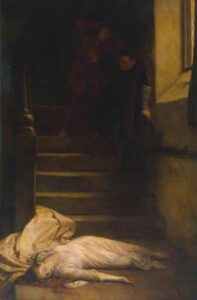
According to a report in yesterday’s “Daily Mail”, entitled “Did Elizabeth I’s lover have wife killed so he could wed the Virgin Queen?”, new evidence has been uncovered which supports the theory that Robert Dudley arranged the murder of his wife, Amy Dudley (nee Robsart), so that he was free to marry Elizabeth I.
Amy’s Death
Amy Dudley’s body was found at the foot of the stairs of Cumnor Place in Oxfordshire, on the 8th September 1560. She had been suffering with a “malady in her breast” (breast cancer) and was thought to be dying and Alison Weir, in “Elizabeth, the Queen”, writes of how it is known that Amy was suffering from depression in early September 1560. Weir’s sources for Amy’s depression include a statement from Amy’s maid, saying that she had heard Amy “pray to God to deliver her from desperation”, and the “Leycester’s Commonwealth” tract which tells of how the Cumnor Place household were so concerned that Lady Dudley was “sad and heavy” that they wanted a doctor to prescribe medicine for her.
Whatever, the state of Amy’s health and mind, she was found dead by her servants when they returned from “Our Lady’s Fair” at Abingdon and at the inquest the coroner ruled that Amy’s death was an accident.
New Evidence
Alison Weir writes of how Alvaro de Quadra reported on the 11th September that Elizabeth I had ordered that the news of Amy’s death should be made public, that it was attributed to accidental causes and that Elizabeth had said that Amy had broken her neck and “must have fallen down a staircase”. However, the original coroner’s report had been found and it does not mention a broken neck!
Historian Steven Gunn, a lecturer at Oxford University, found the coroner’s report in the National Archives while searching through 16th century accident records. According to the report, Amy’s head had two deep wounds caused by two impacts and even though there were no signs of other injuries, whcih one would expect if Amy fell down a flight of stairs, the coroner ruled that Amy’s death was the result of “misfortune”. Gunn copied this report to historian Chris Skidmore who reveals it in his new book “Death and the Virgin” (released on the 25th February 2010), and is quoted in the Sunday Times newspaper as saying “At the very least it [the coroner’s report] casts doubt on the accident theory”.
Did Dudley Blackmail the Jurors?
Skidmore has also uncovered evidence to suggest that Robert Dudley may have attempted to “nobble” jurors to cover up Amy’s supsicious death and that household accounts show that Dudley gave Robert Smith, a courtier and foreman of the inquest jury, several yards of velvet and black taffeta to make clothes. Skidmore also reveals how Dudley asked that the jury be made up of “discreet” men, that one member of the jury (John Stevenson) was employed by Dudley and that Dudley also paid Anthony Forster, owner of Cumnor Place where Amy died, £310 (around £65,000 in today’s money) shortly after Amy’s death.
Gossip Surrounding Amy, Dudley and the Virgin Queen
Robert Dudley had married Amy Robsart, the daughter of Sir John Robsart, in 1550 and it was said to be a love match and what William Cecil described as “a carnal marriage, begun for pleasure”, rather than an arranged marriage. However, Robert Dudley had always been close to Elizabeth I, having known her since childhood and it is thought that their shared experience of being imprisoned in the Tower of London and Dudley’s time at court, away from his wife, brought the two of them closer and drove Robert and Amy apart. As Master of the Horse, Dudley saw Elizabeth on a daily basis and it was not long before there was gossip about Dudley and Elizabeth, and how much she favoured him.
On the 18th April 1559, the Count de Feria, wrote:-
“During the last few days, Lord Robert has come so much into favour that he does whatever he likes with affairs. It is even said that Her Majesty visits him in his chamber day and night. People talk of this freely that they go so far as to say that his wife has a malady in one of her breasts, and that the Queen is only waiting for her to die to marry Lord Robert”
and there were also rumours that Dudley had “sent to poison his wife” (de Quadra) and in early 1560 de Quadra wrote of how Dudley was planning to divorce his wife so that he could be Elizabeth’s consort.
There were also rumours that the Queen had had children by Dudley and a man named Henry Hawkins was punished for saying that “My Lord Robert hath five children by the Queen, and she never goeth on progress but to be delivered.”
However silly or unfounded these rumours, one can only imagine the distress caused to Amy Dudley. Even though she was away from court she must have heard some of these rumours and she must have worried at the closeness shared by her husband and the Queen. No wonder she was described as “sad and heavy” in the late summer of 1560, she was dying and her husband was living it up at court with another woman. Did she believe that her husband was just waiting for her to die?
Theories on Amy’s Death
- Accident – Alison Weir mentions the theory of Professor Ian Aird from 1956, in which he suggests that Amy’s death could have been an accident caused by a spontaneous fracture of the vertebrae as she walked down the stairs. Professor Aird bases this theory on the fact that breast cancer can cause a weakening of the bones.
- Suicide – On the day of her death, Amy ordered all of her servants out of the house, giving them permission to go to Abingdon’s “Our Lady’s Fair” for the day. When some of them protested that it was not “fitting” to go to a fair on a Sunday, Amy was said to have been quite sharp with them, asking them to obey her orders. A Mrs Odingsells refused to go, much to Amy’s displeasure, but Mrs Odingsells did eventually retire to her room, leaving Amy alone. Did Amy arrange to be alone so that she could commit suicide, after all, she was said to be very depressed? Amy’s maid said that she wondered if Amy “might have an evil toy in her mind”, in other words suicide.
In those days, it was believed that suicide was a mortal sin, one that led to eternal damnation, so would Amy have risked her soul to shorten her life? Who knows? Perhaps if she was in enough pain and distress, and felt abandoned by her husband. - Murder arranged by her husband – Did Robert Dudley get rid of Amy so that he could marry Elizabeth? See above for Chris Skidmore’s evidence.
- Murder arranged by William Cecil – This is a theory put forward by Alison Weir. On p108 of my paperback version of “Elizabeth, the Queen”, Weir says:- “One man did profit from the death of Amy Dudley, and that was William Cecil. He was swiftly restored to favour as soon as the news was known and his rival banished from the court, and when he visited Dudley at Kew he did so in the comfortable knowledge that their positions had been reversed and that he now had the upper hand.” His motive for orchestrating the murder was, according to Weir, to stop Elizabeth marrying Dudley and risking her crown and popularity. Suspicion would surround Dudley and Elizabeth would not risk her reputation by marrying him. However, I find it hard to believe that Cecil would have risked the reputation of his beloved Queen for such a plot. I agree with Weir when she says that Cecil was a “perceptive man and he could foresee that if she died in suspicious circumstances, as many people expected her to do, then the finger of suspicion would point inexorably to her husband – as indeed it did. Cecil also knew that Elizabeth , who was very conservative at heart, would be unlikely to risk her popularity and her crown to marry a man whose reputation was so tainted” but I just can’t see Cecil acting on this belief.
- Murder by an enemy of the Crown – I have to agree with Elizabeth Files visitor, Rochie, and “Virgin and the Crab” author, Robert Parry, who both believe that the most plausible explanation, if it was not an accident, is that it was murder committed by an enemy of Elizabeth I and Robert Dudley. There were many people who were against Elizabeth marrying her Master of the Horse and what better way to stop a future marriage than cause scandal and make Robert Dudley look like a murderer? Dudley had already been surrounded by scandal due to his family’s past and due to him being Elizabeth’s favourite and now they could use Amy’s death to bring him down. Did Mrs Odingsells stay behind on that day because she was an accomplice?
- An aortic aneurism – A modern theory that Amy was killed by the terminal enlargement of one of the arteries from the heart. Symptoms of this include depression, fits of anger, mental aberrations and pain and swelling in the chest. According to Alison Weir “sudden slight pressure can cause the bursting of the aneurism, bringing instantaneous death”.
Conclusion
What I don’t get is why the fact that a coroner’s report stating that Amy Robsart suffered two head injuries should implicate Robert Dudley. Even the extra “evidence” of him paying the foreman with material and the owner of Cumnor Place does not necessarily mean that he was guilty, he could have simply been paying off debts and he would have been downright stupid to murder his dying wife! She was ill enough for people to be talking about it so it did appear that she was terminally ill. Surely he would have known that a fall would have looked suspicious seeing as there were already rumours that he was poisoning her. He may have been in love but he still had a brain!
It would be interesting for a pathologist or someone with expertise to look at the coroner’s report and to look at the statements given by Amy’s household and to come up with a conclusion. As someone who does not have any medical knowledge or expertise in pathology, apart from watching CSI or Silent Witness (!), I can’t come up with a solid theory. All I can say is that I don’t believe that it makes sense for either Dudley or Cecil to get rid of Amy and that leaves accident, natural causes or murder by someone unknown.
Anyway, it does sound like Chris Skidmore’s book will be an interesting read but I will take it all with a fairly large pinch of salt!
Sources
- “Elizabeth, the Queen” by Alison Weir
- “Death and the Virgin Queen: Elizabeth, Dudley and the Mysterious Fate of Amy Robsart”
- “Suspicious death that made the Virgin Queen” – An article in “The Sunday Times”
- Did Elizabeth I’s lover have wife killed so he could wed the Virgin Queen? – Article in “The Daily Mail”






